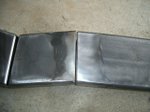After posting up about What buyers are looking for yesterday, I got to thinking about an article I wrote on my website a couple of months ago. I thought it might go well here also. It is a little more specific about what I am looking for when I am looking at a home from a buyer's perspective.
Many people make improvements or modifications to their homes. Some are made to increase the livability of the house, other are made to increase its value. Still others are made to put the house back into working order.
First, I think that improvement needs to be defined. There are a lot of things one can do that "improve" one's home, however many of these items are not really improvements. A good example is replacing the HVAC system. Even when it is replaced with a newer, better, more efficient system, that isn't really considered an improvement. The same would be said of a new roof, windows, or even appliances. I know that appliances are throwing a lot of folks. Those would be considered repairs, or possibly upgrades. However, they are required systems, and their functionality isn't changing. The line between repair and upgrade may be a fine (and fuzzy) line, but generally upgrading would be putting something in that is a little "better" than the neighborhood average. An example would be putting on a "50 Year" roof shingle when most of the other homes in the area are using a 30 year material. The same would be true of a higher quality window or HVAC system. Generally, this type of work maintains the value of the property. It won't really increase it, but if the systems aren't up to at least area norms, the value will be negatively affected. The upgrades may give a little value bump, but their main value will be that they often speed the sale of the property.
The next fuzzy line would be updating. Taking an old kitchen or bath, and putting in new fixtures would be a great example of updating. Keep in mind that updating usually wouldn't involve tearing out the cabinetry or dropping walls and reconfiguring the house. Updating is usually considered improvement, and will increase the value, and possibly decrease the time on the market.
Finally, the real meat of improvement is renovation. This should be reserved to properties that are getting extensive work. I see "renovated" properties all of the time that are minimally updated, but retain outmoded cabinets and other items. These really aren't renovated, and the money that was spent to do something halfway may have been largely wasted. A great example would be throwing some entry level stainless steel appliances in to the kitchen, and then painting the 30 year old cabinets with wall paint, and maybe dropping a new laminate countertop in as well. That might be OK in a lower priced neighborhood where that is the norm, but doing that in an area where the other homes sport granite counters and high end cabinets around expensive appliances is a bad recipe. In this example, the seller might have spent $8,000 on the "mini-renovation," but to bring it up to the neighborhood norms would cost a buyer $20,000. The buyer will be looking to buy the house at a price low enough to allow them to spend that $20k... that means that the seller may not even be able to recoup the $8k they spent.
The flip side of this would be spending $20,000 to redo the master bath in a $200,000 home. Unless the room was trashed, and it needed major infrastructure, the seller is not going to see that money again. Even if it was, the seller can kiss most of that money good-bye.
If one is doing a kitchen gutting remodel, they should expect to spend around 10% of the value of the house on the kitchen, or a little more. This would be the cabinetry, appliances and countertop, including labor. Bathrooms are tougher to gauge, but I would say that one should expect to spend a similar amount to a bit more for all of the bathrooms combined. However, seeing the master suites and the more extravagant bathrooms that many newer and higher end homes may have, that could be off.
Other rooms in the house are just up in the air. They are easier for the buyer to change to suit their needs, and usually only need to be painted or have the floor refinished or re-carpeted at most, if the basic size is there. Small rooms are difficult to fix.
Don't forget the landscaping. From the curb, the house needs to be inviting and neat. It also shouldn't look like it needs a full-time gardener to keep up. Most buyers want the look of a finely designed yard... and to only have to spend 30 minutes a week keeping it up.
The bottom line is that to properly improve a home for resale, one needs to have an overall plan. Appropriate levels of trim need to be used, as pinching the wrong pennies can be very damaging to resale. Finally, I always tell people that they should not wait until sale time to repair/renovate/upgrade/update their home. That way, they will have the opportunity to enjoy the newer, more pleasant environment.









No comments:
Post a Comment